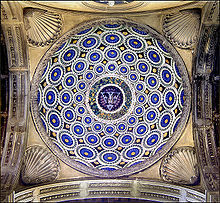A small Chapter House located within Santa Croce and adjacent to the cloister -a typical location for a Chapter House. A Chapter House’s purpose was supposed to be a learning area for the monks dedicated to that particular church. It was commissioned by the powerful Pazzi family who resided in Florence, not nearly as powerful nor prolific as the Medici family; however they often were contenders with the Medici’s when it came to Renaissance clout. The Pazzi Chapel is such a case where the family gained the opportunity to momentarily be above the Medici. As naturally follows, the Pazzi family chose the prolific Filippo Brunelleschi as the architect. As a Chapel House and small burial place for the Pazzi family members, the space needed not to be designed as a large Basilica or play off any of the typical design features that follow suit with a basilica. Instead, Brunelleschi designed a center planned space, focusing on his ideals of perfect geometry forming a rational and ordered space. This small, at first, unassuming, Chapter House becomes an icon of early Renaissance architecture.
The Renaissance was characterized by a new interest in Greek and Roman ideals, humanism (focus on the individual), and Neo-Platonism (combining Christianity with Platonian reasoning). The early Renaissance (which lasted from 1400-1492), flourished in Florence with famous artists such as Donatello, Masaccio, and Verrocchio. The most famous architect was Brunelleschi, the genius who was also an oddity; he designed the Hospital of the Innocence, the Duomo of Florence (where he is buried), and the Pazzi Chapel. Because Brunelleschi lived and worked in an era with a renewed interest in Greek ideals, specifically this current of thinking that was Neo-Platonism perfect geometry was paramount in his design. Plato expressed reality as objects, forces, entities, etc. as incomplete expressions of a perfect form. For example, a pine tree, a bonsai tree, and an oak tree are all trees and they must all possess a certain essence that unites these objects even as they all differentiate in form. So, following Plato’s logic, all the different forms of trees in reality share a common essence of being a tree, but because there’s no example of a perfect or ideal tree in reality (a manifestation of this essence), Plato concludes that there must be a separate world where all these ideal essences reside. He calls this world, the “World of Forms”. To understand this more fully, take the concept of the right triangle (or any geometric shape), there isn’t an example of a perfect right triangle anywhere in the world. Any triangle we draw, build, whatever, is inevitably flawed to a minute scale, but the concept of this perfect triangle still exists and mathematically perfect triangles are constantly used. The Christian Church utilized this system of viewing the world because it was rooted in clear reasoning (not necessarily described in my futile description) and from a well respected, historical source; but most importantly it was easy to masquerade aspects of Christianity as being synonymous with Platonic reasoning because Plato’s World of Forms begins to sound an awful lot like the Christian idea of Heaven(to understand this concept further, check out Stephen West's podcast series entitled "Philosophize This"). This is why artists, sculptors, and architects of the time almost always imbued their work with ideal geometry, either underlying (like many painters) or forefront, such as the work of the architect, particularly Brunelleschi. The aim of Brunelleschi was to create a well-ordered, rational space, originating in ideal geometries thus creating a space that was closer to Heaven or Plato’s world of forms.
The geometric forms Brunelleschi primarily works with in plan and section are the circle, square and triangle. The circle at the time is a representation of wholeness and completion, just as the interior sphere within Pantheon of Rome is a symbolic space for the entirety of different deities. Here Brunelleschi manipulates the sphere, levitating it within his space and allowing it to push and pull through the space in an almost playful manner.
As for the façade of the Chapel, it clearly resembles a Roman triumphal arch. The Corinthian columns, prominent barrel vault, and triangular gable on top of the entrance all reminiscence classical orders and harken back to Greek and Roman temple features. The interior has cool gray and white tones -utilizing pietra serena throughout the chapel.
An obscure, but interesting, connection should be made between this beautiful Chapter House Brunelleschi design in 1442 and Renzo Piano’s California Academy of Sciences constructed in 2008, as Piano’s Museum seems to play upon the same themes of the Pazzi Chapel. Both utilize a regular and formal exterior, only hinting (to greater and lesser extents) at the spatial moves that happen within the space as they play with sphere moving throughout the space.
"Pazzi Chapel - Florence." Pazzi Chapel - Florence. N.p., n.d. Web. 05 Dec. 2016.
West, Stephen. "Philosophize This! by Stephen West on ITunes." ITunes. N.p., n.d. Web. 05 Dec. 2016.
Jodidio, Philip. Renzo Piano. Köln: Taschen, 2012. Print.







No comments:
Post a Comment